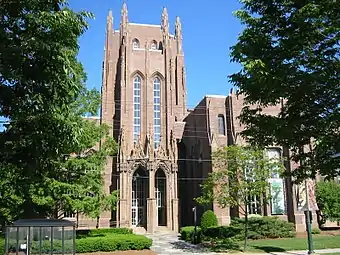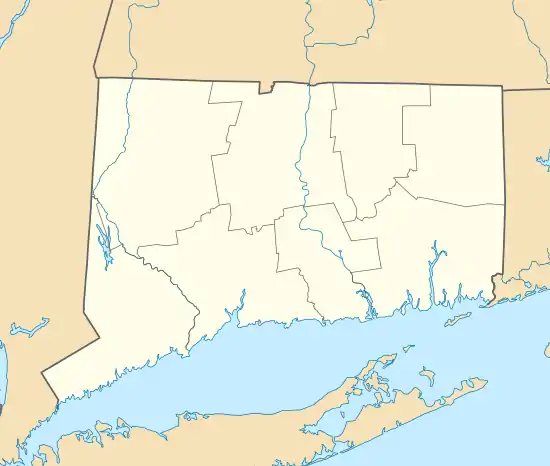Peabody Museum of Natural History
The Peabody Museum of Natural History at Yale University is among the oldest, largest, and most prolific university natural history museums in the world. It was founded by the philanthropist George Peabody in 1866 at the behest of his nephew Othniel Charles Marsh, the early paleontologist. Most known to the public for its Great Hall of Dinosaurs, which includes a mounted juvenile Brontosaurus and the 110-foot-long (34 m) mural The Age of Reptiles, it also has permanent exhibits dedicated to human and mammal evolution; wildlife dioramas; Egyptian artifacts; and the birds, minerals and Native Americans of Connecticut.
 The exterior of the Peabody Museum | |
 New Haven, Connecticut, USA | |
| Established | 1866 |
|---|---|
| Location | New Haven, Connecticut |
| Coordinates | 41.317538°N 72.919863°W |
| Type | |
| Director | David Skelly (as of July 2014) |
| Owner | Yale University |
| Website | http://peabody.yale.edu/ |
The Peabody Museum is located at 170 Whitney Avenue in New Haven, Connecticut, United States, and is run by almost one hundred staff members. While the original building was demolished in 1917, it moved to its current location in 1925, and has since expanded to occupy the Peabody Museum, the attached Kline Geology Laboratory and the Class of 1954 Environmental Sciences Center, parts of three additional buildings, and a field station at the Long Island Sound. The museum also owns Horse Island in the Thimble Islands, which is not opened to the public, but used for experiments. The Class of 1954 Environmental Science Center, completed in 2001 and connected to the museum and the adjacent Kline Geology Laboratory, hosts approximately one-half of the museum's 13 million specimens.
On August 28, 2018, Yale University announced a contribution of $160 million by Edward P. Bass '67 toward the renovation of the Museum.[1][2] The landmark commitment ranks among the most generous gifts to Yale and is the largest known gift ever made to a natural history museum in the United States. Bass's contribution will help to fund the renewal and expansion of the acclaimed museum. The full scope and timeline for the renovation are still under development, but the galleries were planned to be open through June 30, 2020 (the Great Hall of Dinosaurs was open through January 1, 2020), but had to close in March due to COVID-19 and did not reopen before July 1, 2020. Fundraising for the project is ongoing.[3][4]
The Peabody has several world-important collections. Perhaps the most notable are the vertebrate paleontology collections, among the largest, most extensive, and most historically important fossil collections in the United States (see Othniel Charles Marsh, R.S. Lull, George Gaylord Simpson, John Ostrom, Elisabeth Vrba, and Jacques Gauthier), and the Hiram Bingham Collection of Incan artifacts from Machu Picchu, named for the famous Yale archaeologist who rediscovered this Peruvian ruin. Also notable are the extensive ornithology collection, one of the largest and most taxonomically inclusive in the world, and the associated William Robertson Coe Ornithology Library, one of the best in the United States. The collection of marine invertebrates is additionally extensive, having benefitted from the work of such prolific invertebrate zoologists as Addison Emery Verrill. Faculty curators for the collections are drawn from Yale's departments of Ecology and Evolutionary Biology, Geology and Geophysics, and Anthropology. Because these departments maintain a strong tradition of hiring faculty who will perform collections-based research, especially after the renewed support for organismal biology at Yale under President Richard Charles Levin and in particular former provost Alison Richard, nearly all of the collections are under active internal use and enjoy continuous and considerable growth.
The Yale Herbarium is part of the Peabody Museum.[5]
Torosaurus
The museum has erected the first full-scale reproduction of a Torosaurus on Whitney Avenue next to the entrance. The 3 m (9 ft) tall, 7 m (21 ft) long, 3.33 metric ton (7,350 lb) statue was sculpted in clay and cast in bronze, and set on a 4 m (13 ft) tall granite base. The reproduction of T. latus is scientifically faithful of T. latus, and its skin is based on the fossilized skin impressions left by a Chasmosaurus (a closely related ceratopsid).[6]
Exhibits

Permanent exhibits include:
- The Great Hall of Dinosaurs with the skeleton of a Brontosaurus.[7][8]
- The Age of Reptiles Mural is a 110-foot-long (34 m) depiction of dinosaurs in their natural habitats. It was painted by Rudolph F. Zallinger, and is located in the Great Hall of Dinosaurs.
- Fossil Fragments: The Riddle of Human Origins is a new exhibit dedicated to human evolution.
- The Birds of Connecticut Hall has 722 specimens, representing more than 300 of the 382 documented species in the state of Connecticut.
- There are eleven dioramas on the plant and vertebrate ecology of Connecticut. They were designed by James Perry Wilson, F. Lee Jaques, and Ralph C. Morrill.
- The Hall of Mammalian Evolution. Here shows The Age of Mammals mural, also painted by Rudolph F. Zallinger.
- An extensive collection of minerals, primarily from Connecticut.
- Native American artifacts from Connecticut.
- The Hall of Ancient Egyptian Artifacts.
Staff
The current director of the Peabody Museum is David Skelly, a curator of vertebrate zoology and a professor of ecology in the Department of Ecology & Evolutionary Biology and the School of Forestry and Environmental Studies.
The Peabody Museum has curators representing anthropology, botany, entomology, invertebrate zoology, invertebrate paleontology, vertebrate zoology (with individual curators for herpetology, ichthyology, mammalogy, and ornithology), paleobotany, vertebrate paleontology, mineralogy & meteoritics, and historical scientific instruments.
There are almost 100 full- and part-time staff, including curators, assistant curators, curators emeriti, curatorial affiliates, and volunteers. Curators and assistant curators are also faculty members in related departments.[9][10]
History

Othniel Charles Marsh was an undergraduate and later the Professor of Paleontology at Yale University. His education was paid for by his wealthy uncle George Peabody, who began to donate much of his accumulated wealth to various educational institutions at the end of his life. Marsh and his teams discovered dozens of new genera of dinosaurs, including triceratops, stegosaurus and apatosaurus. At the request of Marsh, and to house some of his discoveries, Peabody founded Yale's Museum of Natural History in 1866 with a gift of $150,000.
Yale's collection at the time was mostly minerals, collected by the geologist and mineralogist Benjamin Silliman. Marsh was one of the museum's first three curators, and when Peabody died in 1869 he used his inheritance to fund expeditions which greatly increased the museum's collections. His primary interest was dinosaurs, and during the infamous period in paleontological history known as the Bone Wars, he discovered 56 new species of dinosaur and shipped literally tons of fossils back from the American Southwest. His finds also included fossils of vertebrates and invertebrates, trackways of prehistoric animals, and archaeological and ethnological artifacts.
The museum officially opened to the public in 1876. In 1917, it was demolished and replaced by the Harkness Memorial Quadrangle dormitory. Due to World War I, most of the collections were put in storage until December 1925, when the current building was dedicated. The new building had a great, 2-story hall designed specifically to hold Marsh's dinosaurs.
Some other significant events include:
- In 1930, donation of the Harry Payne Bingham Oceanographic Collection, including the work of artist Wilfrid Swancourt Bronson.[11][12][13]
- In 1931, the mounting of Marsh's Brontosaurus was finished, after 6 years of work.
- In 1947, Rudolph F. Zallinger finished painting dinosaurs in their natural habitats in his 110-foot-long (34 m) mural The Age of Reptiles, after 3 1⁄2 years of work.
- In 1959, Bingham Laboratory was completed.
- In 1963, Kline Geology Laboratory was completed.
- In 1972, the Birds of Connecticut Hall opened.
- In 2001, the interdisciplinary Class of 1954 Environmental Science Center was constructed on the site of the former Bingham Laboratory. It houses collections space for the museum and laboratory space for several curators.
- In 2005, the Peabody unveiled its 21-foot life-size bronze sculpture of Torosaurus—one of O.C. Marsh's famed dinosaur discoveries. The 7,350-pound sculpture sits on a 13-foot, 70-ton base of Stony Creek granite.
- In 2018, the Peabody announced a $160 million transformative gift toward a redefining renovation that will greatly expand its research capabilities, education and collection centers, and its exhibition galleries.
Popular culture
- The museum was featured in The Simpsons episode "Burns, Baby Burns". In the episode Mr. Burns has a relationship with Lily Bancroft and produce an illegitimate son played by Rodney Dangerfield. He flashes back to 1939 for his 25th graduation class reunion. They make love in the museum, specifically in an exhibit featuring Inuit and penguins.[14]
Footnotes
- "Yale Receives $160 Million Gift for Peabody Museum". The New York Times. Retrieved 28 August 2018.
- "Edward P. Bass '67 makes lead gift toward renovating Yale Peabody Museum". Yale University Office of Public Affairs & Communications. Retrieved 28 August 2018.
- "Peabody Evolved: The Plan". Yale Peabody Museum of Natural History. Retrieved 28 August 2018.
- "Peabody Evolved: Support". Yale Peabody Museum of Natural History. Retrieved 28 August 2018.
- "Botany | Collections : Yale Peabody Museum of Natural History". peabody.yale.edu. 2010-11-09. Retrieved 2020-04-25.
- The Torosaurus Project.
- Kelly Glista (April 14, 2015). "Those Old Bones? It Really Is A Brontosaurus". Hartford Courant. Retrieved 2015-04-26.
- Tschopp, E.; Mateus, O. V.; Benson, R. B. J. (2015). "A specimen-level phylogenetic analysis and taxonomic revision of Diplodocidae (Dinosauria, Sauropoda)". PeerJ. 3: e857. doi:10.7717/peerj.857. PMC 4393826. PMID 25870766.

- "Yale Peabody Museum of Natural History: Administrative Staff". Yale Peabody Museum of Natural History. Retrieved 28 August 2018.
- "Yale Peabody Museum of Natural History: Collections Staff". Yale Peabody Museum of Natural History. Retrieved 28 August 2018.
- "Harry Payne Bingham". peabody.yale.edu. Yale Peabody Museum of Natural History. Retrieved 30 August 2015.
- "Wilfrid Swancourt Bronson Archives". Yale Peabody Museum of Natural History. hdl:10079/fa/ypm.ypmar.000051. Cite journal requires
|journal=(help) - Slack, Nancy G. (2010). G. Evelyn Hutchinson and the Invention of Modern Ecology. Yale University Press. p. 125 of 457. ISBN 978-0300161380.
- The Simpsons Archive"Burns, Baby Burns" Archived 2006-01-15 at the Wayback Machine Retrieved July 8, 2012
References
- "The Torosaurus Project at the Yale Peabody Museum". Peabody Museum of Natural History. 2005. Retrieved 2014-07-09.
External links
| Wikimedia Commons has media related to Peabody Museum of Natural History. |
- Peabody Museum of Natural History, Yale University (official website)
